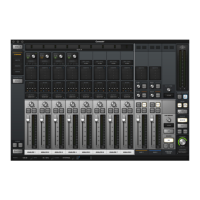Apollo Thunderbolt Software Manual Console Overview 37
When To Use Console
The Console application can be used without a DAW, simultaneously in conjunction with
a DAW, or not at all. These scenarios are covered in greater detail in Working With Apollo.
Console without DAW. Console can be used by itself without the use of a DAW or
any other audio software. Using Console without a DAW provides access to all Apollo
functionality and simplifies the use of Apollo’s digital mixing, monitoring, and Realtime
UAD Processing features when a DAW’s recording and playback features are not needed.
Console with DAW. Console is used at the same time as a DAW when low-latency
monitoring and/or recording of Apollo’s inputs with (or without) Realtime UAD Processing
is desired. In this scenario, Console is used as a front end to control input monitoring
when recording, and the DAW’s software input monitoring feature is disabled. This
workflow completely eliminates the I/O buffering latencies associated with using software
monitoring via the DAW.
Important: To eliminate doubled signals, software monitoring in the DAW must be
disabled when Console is used for input monitoring. Conversely, Console inputs
must be muted if the DAW’s software monitoring feature is enabled.
UAD plug-ins can be used within Console and a DAW simultaneously. In this scenario,
Apollo’s DSP resources are shared between the two applications. Realtime UAD
Processing is available via Console, and buffered (non-realtime) UAD processing is
available via VST, RTAS, AAX 64, or Audio Units plug-ins within the DAW. See UAD
Powered Plug-Ins: Console versus DAW for more details about this scenario.
Tip: Console can be opened or quit at any time, whether or not a DAW is already
running. Console’s settings and UAD plug-ins remain active after the application
is quit.
Interactions Between Console and Apollo
Console’s settings mirror the Apollo hardware. Changes made to one are also made on the
other, and vice versa. If changes are made to Console when Apollo is not connected, then
Apollo is subsequently connected, the Console settings are sent to the hardware.
Important: If Console is launched after changes are made to Apollo using the front
panel hardware controls, the current Console settings will overwrite the changes
made using the hardware controls.

